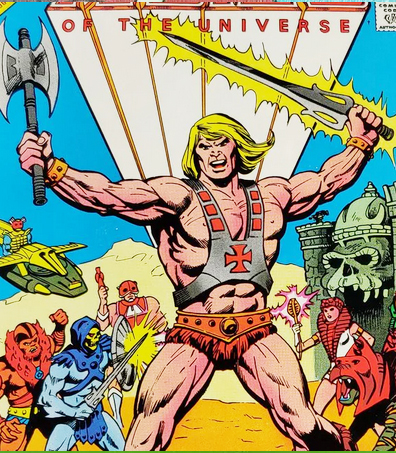The 1980s minted a lot of legends, but few loom as large—literally—as Masters of the Universe (MOTU). Muscular 5.5″ heroes, neon sorcery-meets-sci-fi aesthetics, chunky vehicles, and a cartoon juggernaut made He-Man and Skeletor unavoidable on TV and in toy aisles. Here’s how it started, why it dominated, and how it keeps coming back.
The Birth of He-Man (1982)
After missing the Star Wars license, Mattel forged its own destiny in 1982 with MOTU: big-shouldered figures, bold silhouettes, and a mash-up of sword-and-sorcery plus science fiction. He-Man—“the most powerful man in the universe”—defends Eternia and Castle Grayskull against Skeletor’s dark magic and schemes.
The line’s core heroes—He-Man, Man-At-Arms, Teela, Orko—and villains—Skeletor, Beast Man, Evil-Lyn—were engineered for play: spring-waist power punches, snap-on armor, and bold, readable sculpts. Sets like Castle Grayskull and Snake Mountain, plus vehicles like Battle Cat, Wind Raider, and Land Shark, turned coffee tables into Eternia.
The Animated Series (1983–1985)
Filmation’s He-Man and the Masters of the Universe (130 episodes) pushed MOTU from hot toy to cultural monolith. Episodes followed a tight rhythm: Skeletor’s plan, He-Man’s counter, and a quick end-of-episode moral—family-friendly and parent-approved. The signature art style—square-jawed heroism vs. cackling villainy—became visual shorthand for 80s cartoons.
She-Ra: Princess of Power (1985)
She-Ra broadened the universe and audience: Adora, He-Man’s twin, wields the Sword of Protection to defend Etheria against Hordak. While the show targeted girls, it developed its own passionate base and remains a touchstone character for many fans.
The 1987 Live-Action Film
Masters of the Universe reached theaters in 1987 with Dolph Lundgren (He-Man) and Frank Langella (Skeletor). Budget choices and a fish-out-of-water plot on modern-day Earth made it a quirky entry at the time, but it’s aged into a cult classic—helped by Langella’s gloriously theatrical Skeletor.
Why MOTU Worked: Toy Design in Overdrive
- Silhouette sells: 5.5″ scale, exaggerated anatomy, big armor—readable from across an aisle.
- Action features: spring waists, caps, grapples—kids could feel power in one flick.
- World building: playsets, mounts, and vehicles made Eternia a place you could map.
- Character variety: heroic warriors, evil henchmen, the Snake Men, the Horde—freshness each wave.
Decline and Dormancy (Late 80s)
By 1986–88, trends shifted and the line cooled; the Filmation series wrapped and the brand slowed in stores. But the DNA was too strong to stay shelved for long.
Revival Cycles: 2002 to Today
The early 2000s rebooted toys and TV with sharper sculpts and anime-inflected storytelling. In the 2020s, Netflix’s Masters of the Universe: Revelation (Kevin Smith) revisited the mythos with a darker tone and legacy cast, while parallel lines delivered modern collector figures that nod to the originals.
Collector Notes
- Completeness matters: weapons, armor halves, and stickers (e.g., control panels) drive value.
- Playset condition: Castle Grayskull/Snake Mountain often miss small accessories—inventory carefully.
- Storage & display: avoid sun/heat; stands help with shelf dives; bag small bits separately.
Legacy
MOTU fused toy engineering with an instantly graspable myth. The battle cry—“By the power of Grayskull… I have the power!”—still echoes because the formula works: bold characters, tactile play, a world worth defending. For more 80s synergy, jump to G.I. Joe, Transformers G1, and ThunderCats.
